When the UN World Food Program makes records, it does not bode well for the world. Since 2020, when the program has helped 116 million people, every year has been a record. This year, it will help more than 150 million people.
Acute hunger is caused by three things: conflict, climate disruption, and the dramatic economic and social consequences of the COVID pandemic. They are exacerbated by structural weaknesses such as inequality and the apparent lack of social safety nets that make the situation dramatically worse.
At the beginning of 2022, food prices were the highest in the last 10 years and fuel prices were the highest in seven years. Rising prices compound the challenges for those who can barely afford food in normal times. This problem is greatly aggravated by the war in the Ukraine.
Ukraine and Russia War impacts on world Food crisis
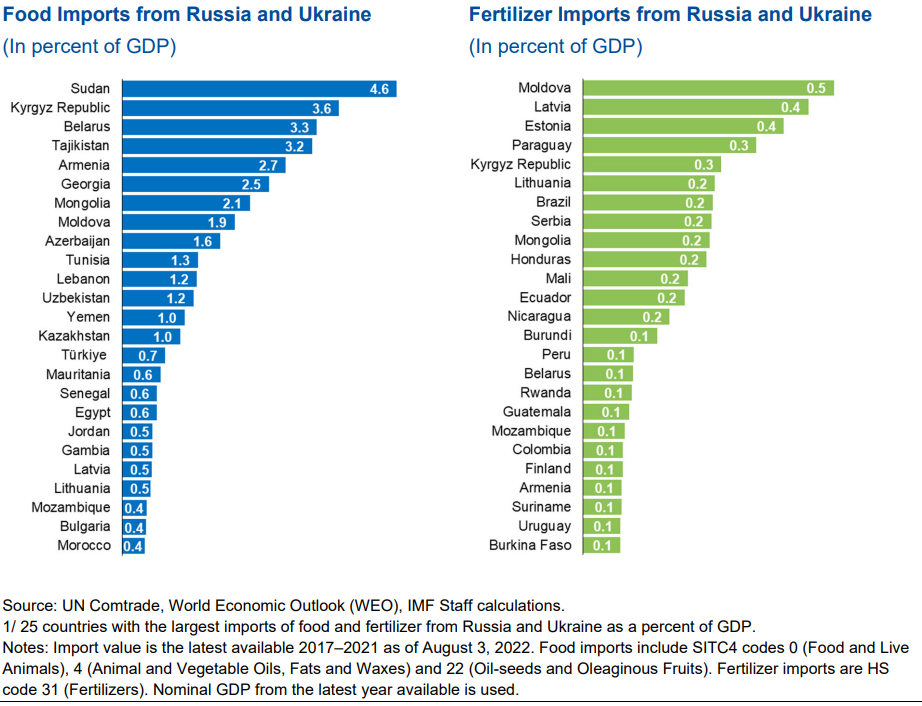
Ukraine and Russia are important exporters of agricultural products and production inputs such as fertilizers and energy.
Ukraine was also the largest grain supplier to the World Food Program before the war. Ukraine and Russia, China together produce 30% of the world’s wheat, 20% of its corn, and 75% of its sunflower oil. In addition, several food-exporting countries implemented restrictions on food and fertilizer exports to support domestic food availability. The current and projected supply of food and fertilizers resulted in a significant increase in world food supplies and created food shortages in countries unable to move supplies quickly, putting additional pressure on prices that had reached historic highs before the war began.
Causes of Food insecurity
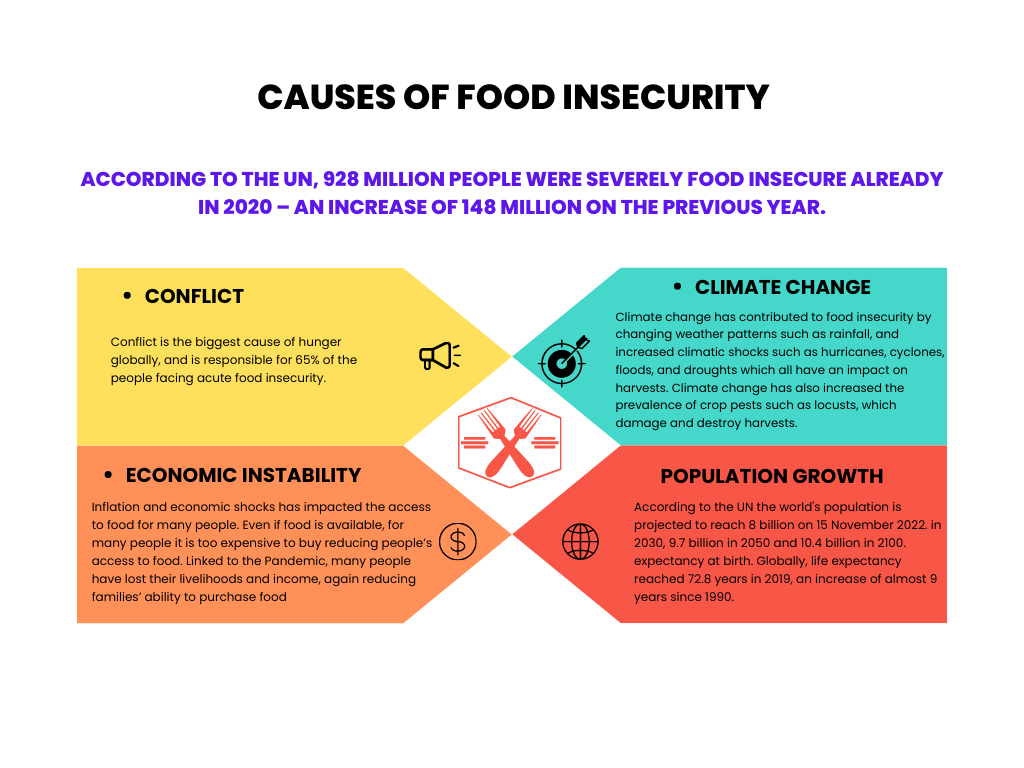
Governments spend about $630 billion on agriculture each year, but the report found that most of that money exacerbates inequality, damages the environment, and prevents the growing of more nutritious and diverse food.
The State of Food Security and Nutrition in the World 2022 presents a new model for existing public funds that can make food more affordable, improve access to healthy food, protect land and water resources, and empower smallholders.
In low-income countries whose economies depend on agriculture, funding from rich countries is key to their transition to more sustainable food systems. External aid for climate adaptation, especially for smallholder farmers, must be urgently scaled up to meet and exceed current pledges.
Cost of Healthy Diet
Although hunger and malnutrition are not often the focus of the news media, they are issues that affect millions of people every day.
- According to the Food and Agriculture Organization of the United Nations (FAO), more than 3 billion people could not afford a healthy diet in 2020, which is 112 million more than in 2019.
- The increase was partly due to higher food prices. The costs of healthy eating will increase by 3.3% from their level in 2019.
- In August 2022, the FAO food price index increased by 40.6% from the average of 2020.
- If income levels do not rise at the same rate, the crisis in healthy eating will worsen, particularly in low-income countries where food inflation is rampant.
Price and affordability of a healthy diet
According to the FAO, a healthy diet is one that meets the daily energy needs and the requirements of the country’s food and nutrition recommendations.
(Un)affordability is measured by comparing the cost of a healthy diet with national income.If the cost exceeds 52% of the average household income, the diet is not considered affordable.
Here is an overview of the population that cannot afford a healthy diet and the cost of such a diet worldwide:
- In 52 countries, more than half of the population cannot afford a healthy diet. Most of them are in Africa, and the rest are in Asia, Oceania, and the Americas.
- In contrast, in four countries—Azerbaijan, Iceland, Switzerland, and the United Arab Emirates—everyone can afford a healthy diet. Most European and developed high-income countries face a similar situation, with more than 95 percent of the population able to afford a healthy diet.
- If you calculate the percentages, Asia has the highest number of people who cannot afford a healthy diet: 1.89 billion people, of whom 973 million live in India alone. Another billion people live in Africa, and about 151 million in the Americas and Oceania.
- While hunger is a global problem, it is particularly acute in African countries, which include all of the top 20 places in the table above.
Africa’s deepening food crisis
In many sub-Saharan countries, more than 90 percent of the population cannot afford a healthy diet.
Sub-Saharan Africa is particularly vulnerable to extreme climate events and the resulting fluctuations in food supplies. About a third of the world’s droughts occur in this region, and some sub-Saharan countries are also heavily dependent on food imports.
Russia’s attack on Ukraine aggravated the crisis, and many African countries import more than 50% of their wheat from countries in conflict.
The rise in food prices caused by this supply chain disruption has led to double-digit food inflation in many African countries, meaning more people cannot afford a healthy diet.
The Horn of Africa region, at the eastern tip of Africa, is particularly turbulent. All countries in the region depend on Russia and Ukraine for wheat; Eritrea (100%) and Somalia (>90%) are high on the import dependence table. In addition, the region is experiencing its worst drought in40 years and ongoing political conflicts As a result, 22 million people die of starvation.
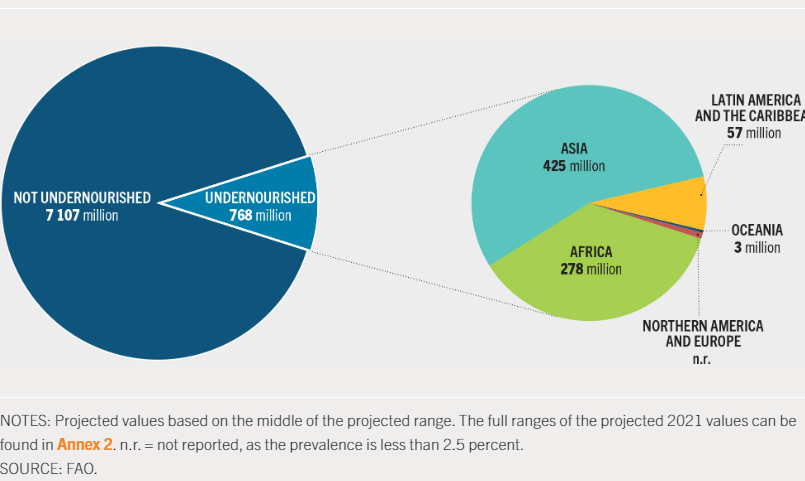
Population growth and food security
According to predictions, the world population will exceed 8 billion people in November 2022, and many of the fastest-growing countries will also experience food insecurity.
By 2050, the world’s population is likely to increase by 35 percent, and crop production will need to double to meet the growing demand for food. Since agriculture is one of the largest emitters of greenhouse gasses, this crop growth must also be environmentally sustainable.
As the impact of climate change intensifies and the demand for food increases, reducing food waste, building climate-resilient agricultural infrastructure, and improving agricultural productivity are central to the sustainable reduction of food insecurity.
While they aren’t often the focus of news media, hunger and undernourishment are problems plaguing millions of people every day.
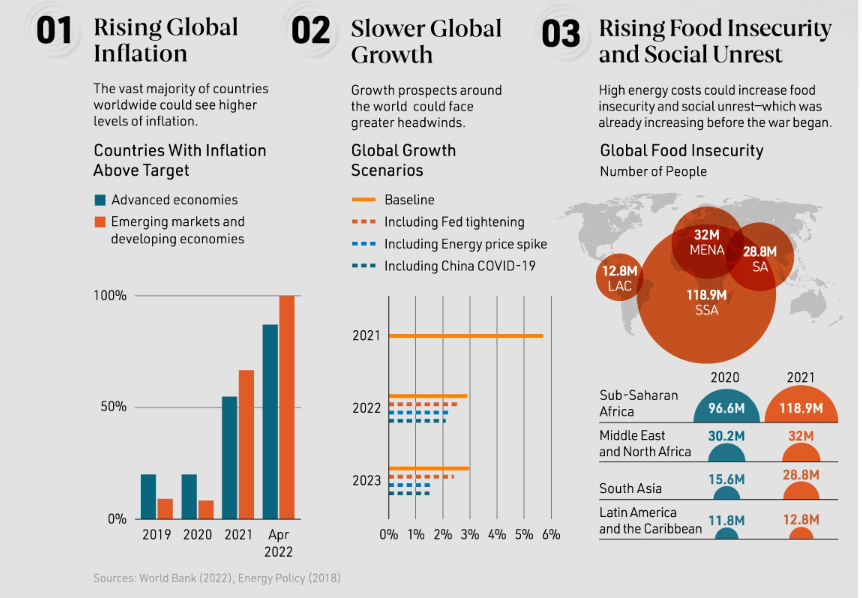
Solutions towards Food Insecurity:
1. Agriculture
Polyculture and crop rotation
Polyculture is the cultivation of two or more crops on one land at the same time. In countries where multiple cultivations is not possible due to climate, farmers use crop rotation.
Crop rotation is the possibility of growing several plants on the same land in a certain order, after the change of seasons. Consequently, the same crop is not continuously planted on the same land. It is a strategy that helps farmers overcome soil erosion and avoid the decline in soil fertility, which is crucial for maintaining and increasing food production.
2. Social
Supporting local farmers
Customers can help local farmers by purchasing locally produced food. This helps to diversify the country’s source of food supply in addition to food imports.
It improves the country’s food security as dependence on food imports decreases. Local farmers often face strong competition from large agricultural companies that control the majority of the food market.
By buying locally produced food, consumers can help local farmers maintain their share of the food market.
3. Population control
In many LDCs, food production growth is slower than population growth, especially in places like India, where hunger and malnutrition are widespread.
- Therefore, controlling population growth is necessary so that people have enough food.
- One way to solve this problem is that people to be educated about family planning and have access to reproductive health services.
- For example, in a village in the Philippines, a community-based family planning program was launched to provide people with contraceptives to curb population growth and solve the food problem. disadvantages.
4. Political and economic
There is a need for better management and treatment of the food problem at the international level through political and economic strategies.
1) National strategies (agricultural policy and agrarian reform)
2) Agricultural policy
Using unused Land
Development of unused land for agricultural and residential use
- Farmers can be provided with land, seeds, and tools for farming.
- Construction of modern crop processing facilities
Limits
National food security may be at risk because cash crops such as oil palm are preferred over food crops due to higher incomes.
Planting cash crops requires a lot of capital and is exposed to fluctuations in world market prices, which is a relatively high risk for farmers. for other types of cultivation
5. Technological
- One way to deal with food shortages is to improve food storage and transportation
- The use of cold and refrigerated storage or delivery trucks allows food to stay fresh longer
- Food waste should be reduced because food doesn’t spoil until it arrives. customers
- Farmers in LDCs can use a simple but effective technique like a silo, which is an airtight structure for storing crops.
- Cold storage can be used to distribute the harvest to places that are further away from the production site. This makes it possible to offer a greater variety of food to a greater number of people.
Limitations:
- Refrigeration of food in large quantities is very expensive and increases food production costs.
- Poor farmers may not be able to afford silos.
- Fungus can develop if grains are not dried before storage in silos
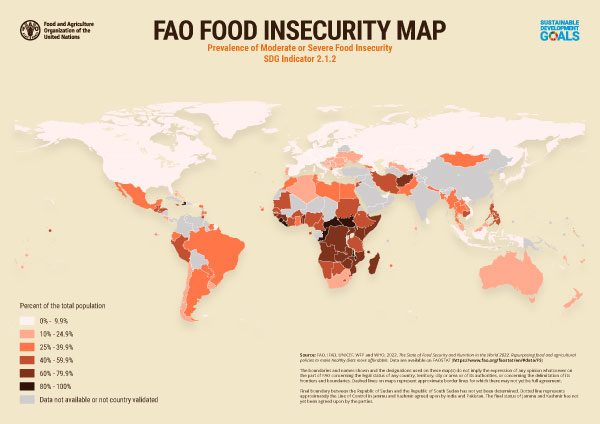
Cultivation technology
Green revolution including the development of high-yielding varieties, improvements in irrigation technology, and the use of chemical fertilizers and pesticides
Some examples of irrigation include:
Flooding: irrigation water delivered over-irrigation of the entire surface, such as a rice field, consisting of several sections of pipe connected together and supported on a truss, mounted on wheeled towers and sprinklers along its entire length. Tubes are mechanically moved around the center.
- Made it possible to grow in areas previously considered unsuitable for agriculture, e.g. irrigation allowed farming in areas that were previously too dry to grow crops.
- To make agriculture more efficient, reducing the dependence on work, e.g. the use of computers in Singapore’s high-tech farms has meant that those farms have fewer workers to cultivate the crops.
Limitations:
Environmental problems can result if not properly managed, e.g. irrigation can cause problems such as waterlogging and salinization
Biotechnology
When used in food production this is often known as genetic engineering. Food could be produced in areas previously considered unsuitable for agriculture.
Plants have been improved by biotechnology, they can withstand changes in weather e.g. decrease in rainfall or an increase in temperature
This helps to stabilize the yield because the yield is not affected by weather fluctuations
Limited use of biotechnology
Biotechnology is used only in the production of certain foods such as corn, soybeans, and canola. for cultivation Not used in the production of other crops such as cassava, sorghum, and banana
- One way to address food shortage is to improve the storage and transportation of food
- The use of refrigerated and frozen warehouse storage or delivery trucks can allow food to be kept fresh for a longer period of time
- Food wastage will be reduced as food will be spoilt before reaching customers
- In LDCs, farmers may make use of simple but effective techniques such as a silo, which is an airtight structure for storing crops.
Food waste to be reduced
- Longer shelf life allows food to be shipped further from the producing country
- Using Good packaging and working on increasing product shelves to restore the food quality components helps reduce food waste
Increased yield
- Increased productivity leads to higher incomes for producers and lower prices for consumers
- Countries must be self-sufficient in food production and reduce dependence on food imports
- Consumers get more food due to low wages. food prices
Limits
Large capital investments
GM crops are mostly grown on large commercial farms in advancing countries
Food safety
Many consumers are wary of consuming genetically modified foods. As a result, the production of genetically modified foods is low because demand is low.
Conservation of water and soil
Water and soil are conserved by no cultivation. Farming without removing weeds from the soil and creating rows to plant the soil is known as no-cultivation.
- This method allows you to preserve the leaves and branches of the previous growth. in season on the soil surface.
- It maintains soil quality by breaking up dead plant material that returns nutrients to the soil.
- It helps in soil conservation where the soil is protected from erosion or degradation.
Renting farmland from other countries
Some countries that do not have enough land suitable for cultivation can rent farmland from other countries.
In Ethiopia, food production cannot sustain its population, and agricultural land is even leased, although several million people depend on food aid.
However, leasing land to other countries can generate income that can be channeled back to help local farmers further improve their farming methods. local food production
Trade Finance
Improving trade finance and supply chains is critical to countering the current food price shock. Funding for Business has already been disrupted during the COVID-19 pandemic. The war in Ukraine and the associate. Food price increases widened the trade finance deficit even more.In response, multilateral
Development banks (MDBs) are increasing their financing arrangements. For example, the European Bank for Reconstruction and Development (EBRD) increased the number of commitments to finance trade in agricultural inputs, agricultural goods, and other foodstuffs from 800 million euros to at least a billion euros per year. until the end of 2023.
The International Finance Corporation (IFC) is working to expand trade finance solutions to fertilizer and plant nutrition traders, and the Multilateral Investment Guarantee Agency (MIGA) is committed to providing trade finance for short-term imports and exports of food and agricultural products.
Food Programs and Aid
Food programs are initiatives that can be initiated either by national governments or by international organizations such as the United Nations and the World Bank.
Food programs are a form of food assistance. Food aid means getting food to all people through international funding and support.
Examples of food programs designed by international organizations and their effectiveness
United Nations World Food Program (UNWFP)
Emergency response
Provision of relief during wars and natural disasters
Food was successfully delivered to 99.5% of targeted Sudanese food recipients.
WFP was able to provide food For 1.5 million of the 2.5 million people affected by Somalia’s food crisis.During such crises, food prices can rise, resulting in high costs for UNWFP.
The extent of their help may also be limited by how much money they receive from donors.
World Bank Funds
Financial Intermediation Fund (FIF)
Global Agriculture and Food Security Program (GAFSP) The Global Agriculture and Food Security Program was established in 2010. It is a multilateral financial mechanism that supports national and regional strategic plans for agriculture and food security in poor countries.

- The African Development Bank (AfDB) announced a US$1.5 billion fund to boost grain production to help avert potential food shortages stemming from the war with Ukraine.
- In Ukraine, the European Bank for Reconstruction and Development (EBRD) is supporting businesses and public services affected by the war, through deferred loans, liquidity support, and trade finance.
- The Inter-American Development Bank (IADB) is supporting countries in need of additional financing for social protection purposes, notably in Haiti and Honduras.
- The Asian Development Bank (ADB) is working, including with the WFP and FAO, to address severe food insecurity through emergency food assistance, food-for-work, and cash-for-work programs (for example, in Afghanistan and Sri Lanka).
- The International Fund for Agricultural Development (IFAD) has set up the Crisis Response Initiative aimed to address urgent needs to prevent hunger and food insecurity caused by the war in 22 countries primarily in Africa and Asia.





Leave a Reply